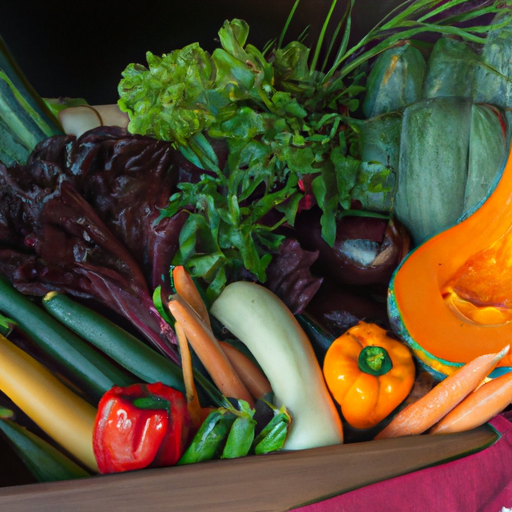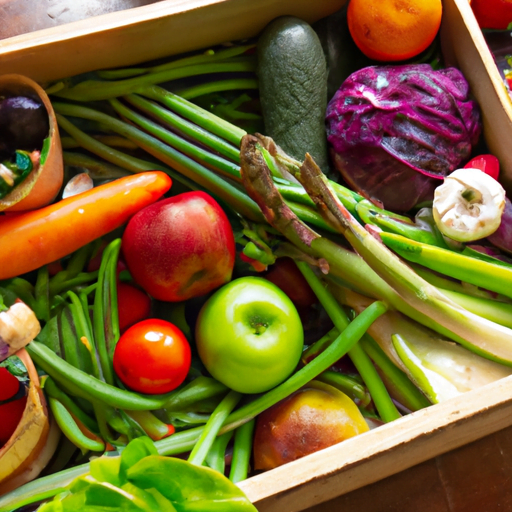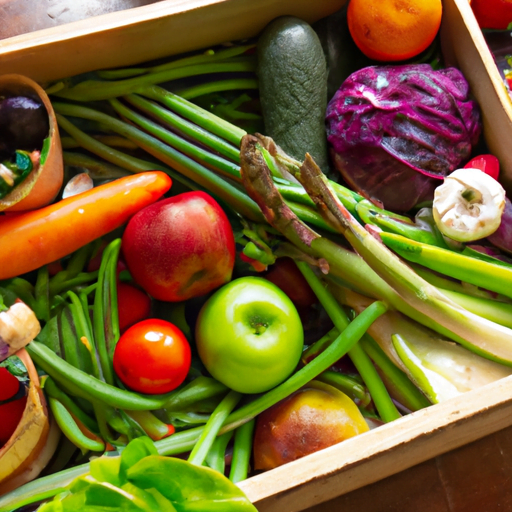So, you’re interested in off-grid living and want to know how to store vegetables long-term without the luxury of a refrigerator, huh? Well, you’ve come to the right place! It’s actually possible to keep your veggies fresh and crisp for an extended period of time using some creative methods that don’t rely on electricity. In this article, we’ll explore a few of these techniques and discuss how they can help you store your vegetables for as long as possible.
Now, let’s dive into the details. One method you can try is root cellaring. This involves storing your vegetables in a cool, dark, and humid environment, such as a basement or cellar. By maintaining the right temperature and humidity levels, you can keep your veggies in prime condition for months. We’ll explain the specifics of root cellaring and how to create an optimal storage space for your vegetables.
Another option is to preserve your vegetables through the process of fermentation. This ancient technique not only extends the shelf life of your veggies but also adds a tangy flavor and valuable probiotics to your diet. We’ll walk you through the steps of fermenting vegetables and discuss which types are best suited for this preservation method.
And finally, we’ll touch on the topic of dehydration. By removing the moisture from your vegetables, you can store them for a significantly longer time. Dehydrated veggies are not only convenient to store, but they also retain most of their nutrients. We’ll explore different methods of dehydration, including sun-drying and using a dehydrator, and provide useful tips for ensuring that your dehydrated veggies stay fresh and tasty.
So, whether you’re considering off-grid living or simply want to explore alternative methods of storing vegetables, this article will provide you with some creative ways to store your veggies long-term without relying on refrigeration. Get ready to learn some valuable techniques that will help you enjoy the freshness of your homegrown produce year-round! Creative Ways to Store Vegetables Long-Term without Refrigeration
Off grid living can present unique challenges when it comes to storing your vegetables long-term. Without the convenience of a refrigerator, it becomes crucial to explore alternative methods that can preserve the freshness and nutritional value of your produce. In this article, we will discuss various creative ways to store vegetables long-term without refrigeration, including canning, dehydrating, pickling, fermenting, and freezing.

Canning
Canning is a timeless method that allows you to store vegetables for an extended period. There are two main canning techniques: water bath canning and pressure canning.
Water Bath Canning
Water bath canning is suitable for high-acid foods like tomatoes, pickles, and fruits. To start, you will need a large pot, canning jars, lids, and a jar lifter. The step-by-step process involves preparing your vegetables, heating them in jars with a water bath, and sealing the jars tightly.
Pressure Canning
Pressure canning is necessary for low-acid foods like most vegetables and meats. This method requires a pressure canner and enables you to can vegetables safely. The pressure canner creates a high-pressure environment that kills harmful bacteria and ensures a longer shelf life for your produce.
Equipment Needed
Regardless of the method you choose, some basic equipment is necessary for canning, such as mason jars, lids, bands, a canner, a jar lifter, and a canning funnel. These tools will ensure that your canning process is successful and your vegetables are properly preserved.
Step-by-Step Process
Canning vegetables involves several steps, such as cleaning and preparing the vegetables, sterilizing the jars, filling the jars with the produce, sealing the jars tightly, and processing them using the appropriate canning method. The detailed step-by-step process can be easily found online or in canning recipe books.
Dehydrating
Dehydrating is another excellent method for storing vegetables long-term without refrigeration. It involves removing moisture from the vegetables, which inhibits the growth of bacteria and other microorganisms.
Sun Drying
Sun drying is the oldest method of dehydration and only requires sunlight and a flat drying surface. This method is ideal for dry climates and can take several days to complete. While it may not be practical for everyone, sun drying is an energy-efficient option that produces delicious dehydrated vegetables.
Dehydrator
Using an electric food dehydrator is a more convenient and efficient way to dehydrate your vegetables. These compact machines have adjustable temperature settings and multiple trays, allowing you to dry different vegetables simultaneously. Simply slice your vegetables evenly, place them on the trays, and let the dehydrator work its magic.
Preparation
Before dehydrating your vegetables, it is important to wash them thoroughly and remove any blemishes or dirt. For some vegetables, blanching them quickly in boiling water before dehydrating can help preserve their color and flavor.
Drying Process
Once your vegetables are prepared, place them on the dehydrator trays in a single layer, without overlapping. Set the temperature according to the manufacturer’s instructions and let the dehydrator do its job. The drying time can vary depending on the vegetable and the desired level of dehydration. Make sure to store your dehydrated vegetables in airtight containers to keep them fresh for an extended period.

Pickling
Pickling is an ancient preservation method that involves immersing vegetables in a brine or acidic solution. This process not only extends their shelf life but also adds a unique and tangy flavor to the vegetables.
Pickling Methods
There are various pickling methods, including refrigerator pickling, quick pickling, and traditional pickling. Refrigerator pickling involves storing the pickles in the refrigerator for a short period, usually a few weeks. Quick pickling uses a higher concentration of vinegar, sugar, and spices and does not require long-term storage. Traditional pickling involves using a hot water bath or steam canning process to seal the jars and preserve the pickled vegetables for a longer duration.
Brine Preparation
To successfully pickle vegetables, you need to prepare a brine solution. A basic brine typically consists of water, vinegar, salt, and sugar, but you can customize it to suit your taste preferences. Adding spices and herbs can also enhance the flavor profile of your pickles.
Jarring and Sealing
After preparing the brine and the vegetables, pack them tightly into sterilized jars. Make sure to leave some headspace at the top of the jar, as the vegetables will expand during the pickling process. Seal the jars tightly and process them using the appropriate method, whether it be a water bath canning or steam canning.
Flavoring Options
One of the exciting aspects of pickling is the ability to experiment with different flavors and spices. You can add garlic, dill, chili peppers, or any other herbs and spices to the brine to create unique pickles that suit your taste. Feel free to get creative and discover new flavor combinations!
Fermenting
Fermenting vegetables not only extends their shelf life but also enhances their nutritional value by promoting the growth of beneficial bacteria.
Fermentation Basics
Fermentation is a natural process that involves converting sugars in the vegetables into lactic acid through the action of bacteria. This lactic acid creates an acidic environment that prevents the growth of harmful bacteria. The most common fermented vegetables include sauerkraut, kimchi, and pickles.
Fermenting Vegetables
To ferment vegetables, you need to submerge them in a brine solution or pack them tightly in a fermentation vessel. The vegetables should be fully submerged in the brine to prevent the growth of mold or other undesirable microorganisms. The fermentation process can take anywhere from a few days to several weeks, depending on the vegetable and the desired level of fermentation.
Fermentation Containers
Various fermentation containers are available, including glass jars, ceramic crocks, and specialized fermentation kits. These containers typically have airlocks or lids that allow gases to escape while preventing oxygen from entering, creating an anaerobic environment ideal for fermentation.
Storage and Care
Once the fermentation process is complete, you can transfer the vegetables to airtight containers and store them in a cool, dark place like a root cellar or a cool storage chamber. Make sure to monitor the fermentation process regularly and discard any vegetables that show signs of spoilage.
Freezing
Freezing is a straightforward and practical method for preserving vegetables long-term without refrigeration. However, not all vegetables are suitable for freezing, as their texture and flavor may be affected.
Vegetables Suitable for Freezing
Some vegetables freeze well and retain their quality when thawed. These include leafy greens, peas, corn, beans, and peppers. It is important to blanch these vegetables before freezing them to ensure the best results.
Blanching
Blanching involves briefly boiling the vegetables in salted water, then promptly transferring them to an ice bath to halt the cooking process. Blanching helps preserve the color, texture, and flavor of the vegetables while also killing any potential bacteria.
Packaging
Once the vegetables are blanched and cooled, it is crucial to remove as much air as possible from the packaging to prevent freezer burn. You can use vacuum-sealed bags, airtight containers, or freezer-safe zip-top bags. Label each package with the contents and the date to keep track of your inventory.
Freezing Techniques
To maximize freezer space and prevent the vegetables from sticking together, flash freezing is a useful technique. This involves spreading the blanched vegetables in a single layer on a baking sheet and placing them in the freezer until frozen solid. Once frozen, you can transfer them to your preferred storage containers.
Other Alternatives to Refrigeration
In addition to the preservation methods mentioned above, there are alternative storage options that can help keep your vegetables fresh without refrigeration.
Root Cellars
A root cellar is an underground storage space that provides a cool and humid environment, ideal for storing root vegetables. By utilizing the natural insulation of the earth, a root cellar can maintain a stable temperature throughout the year.
Sand Storage
Another way to store root vegetables without refrigeration is through sand storage. Simply bury your root vegetables, such as carrots or potatoes, in a box filled with dry sand. The sand helps regulate humidity and provides insulation, keeping the vegetables fresh for an extended period.
Cool Storage Chambers
If you have some space available, you can create cool storage chambers using straw bales or cinder blocks. These chambers are well-ventilated and maintain a relatively cool temperature, making them suitable for storing vegetables like squash or pumpkins.
Ventilated Shelves
For vegetables that prefer cooler temperatures but also require airflow, ventilated shelves can be a practical storage option. Constructing shelves with wire or slatted wood allows air to circulate around the vegetables, maintaining their freshness and preventing spoilage.
Factors to Consider
When storing vegetables long-term without refrigeration, there are certain factors you should keep in mind to ensure optimal results.
Proper Vegetable Selection
Not all vegetables have the same shelf life or storage requirements. Some vegetables, like onions and garlic, have a longer shelf life and are more forgiving during storage. It is essential to know which vegetables you have and their specific storage requirements.
Preparation and Cleaning
Before storing your vegetables, make sure to clean them thoroughly and remove any damaged or spoiled portions. Excess moisture or dirt can accelerate spoilage, affecting the quality of your stored produce.
Ideal Storage Conditions
Different vegetables require specific storage conditions, such as temperature, humidity, and airflow. Understanding these requirements and providing suitable storage conditions will maximize the longevity of your vegetables.
Rotation and Monitoring
Regularly checking on your stored vegetables and rotating them is crucial to prevent spoilage. Use the “first in, first out” method to ensure you use the oldest produce first and keep track of their condition.
Benefits of Long-Term Vegetable Storage
Creative ways to store vegetables long-term without refrigeration offer numerous benefits beyond convenience.
Food Security
Storing your vegetables long-term ensures a steady supply of fresh produce, even during periods of scarcity or emergencies. It provides a sense of security, knowing that you have access to nutritious food regardless of external factors.
Reducing Food Waste
Storing your own vegetables long-term reduces the dependency on store-bought produce, thereby minimizing the amount of food waste generated. It allows you to fully utilize your harvest and preserve the excess for future consumption.
Cost Savings
By storing your own vegetables long-term, you can save money by avoiding frequent trips to the grocery store and taking advantage of seasonal abundance. You will also have access to high-quality, organic vegetables without the premium price.
Preserving Nutritional Value
Proper storage techniques help retain the nutritional value of your vegetables, ensuring that they remain rich in vitamins, minerals, and antioxidants. This enables you to enjoy the full benefits of your homegrown produce throughout the year.
In conclusion, there are numerous creative ways to store vegetables long-term without relying on refrigeration. Whether you choose canning, dehydrating, pickling, fermenting, freezing, or alternative storage methods, these techniques allow you to enjoy the freshness and nutritional value of your vegetables even in off-grid or self-sufficient living situations. Explore these methods, experiment with flavors and textures, and discover the joy of long-lasting, home-preserved vegetables!




